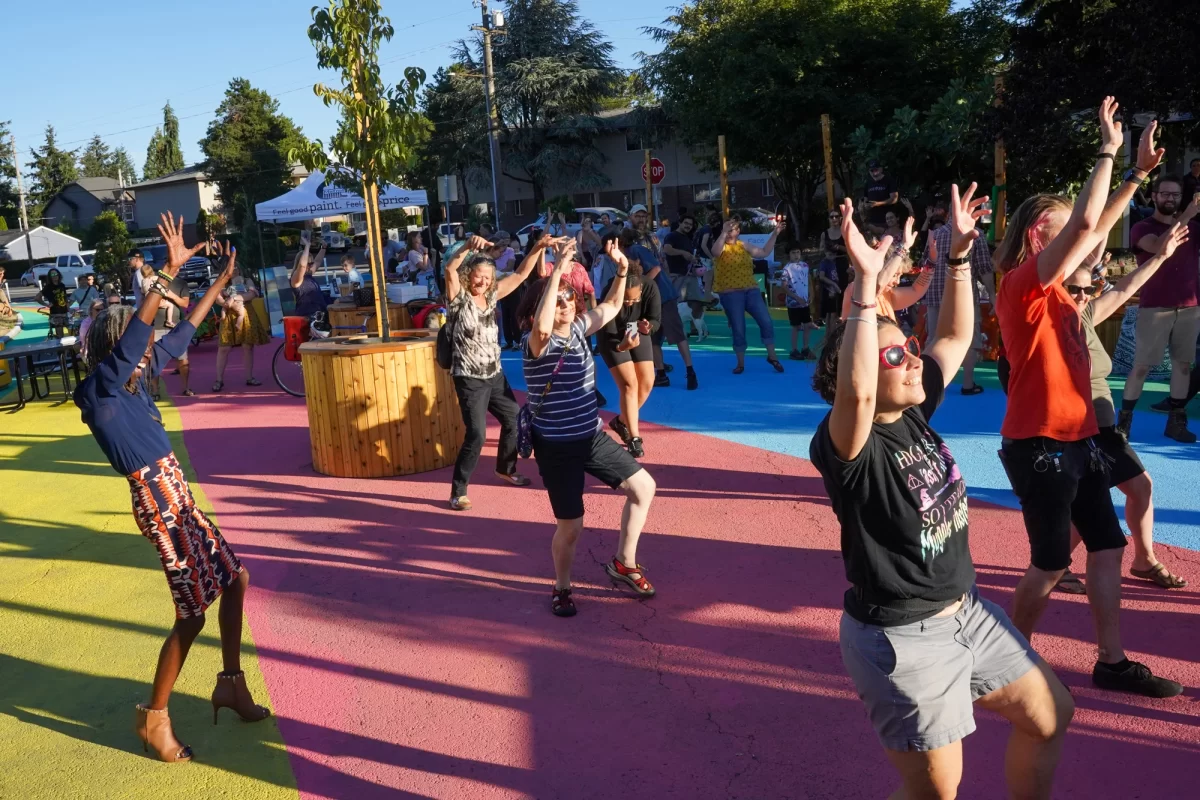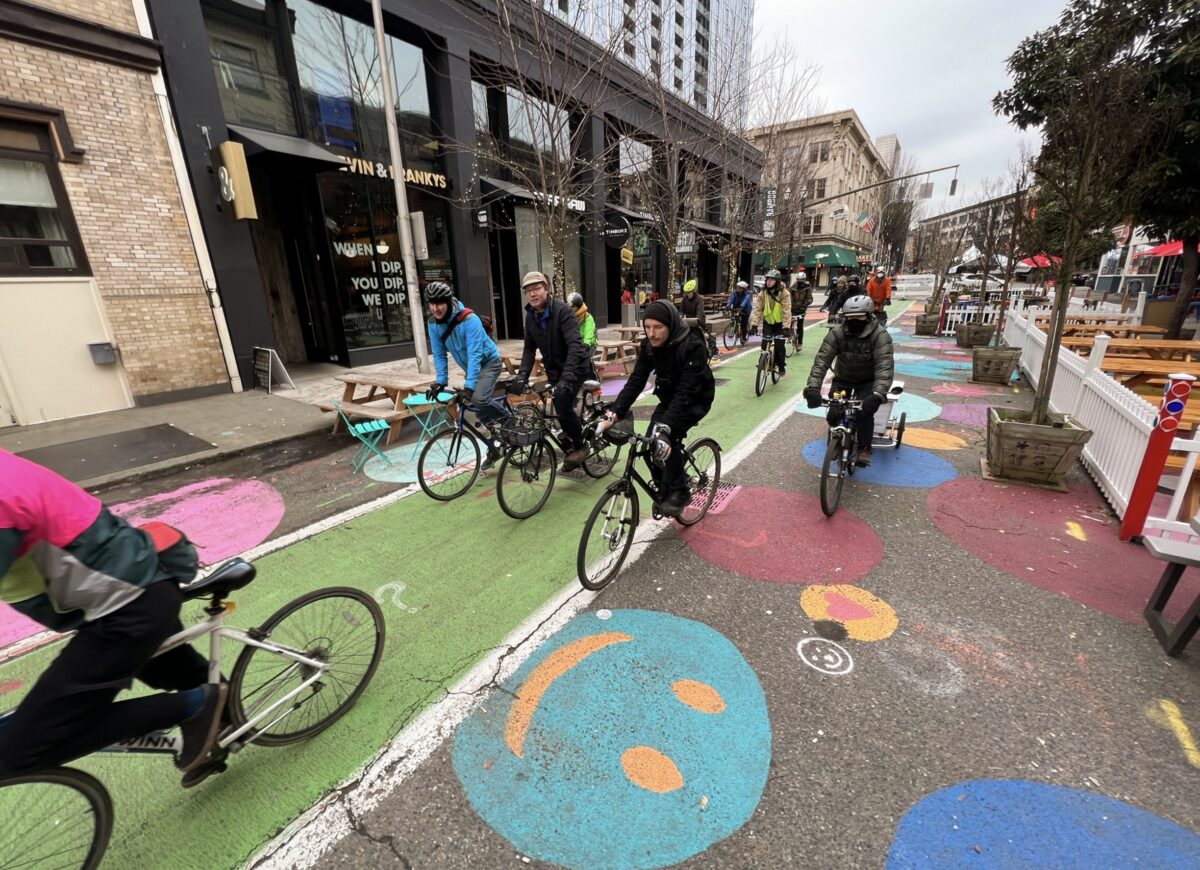“Plazas like these will help us make Portland a more inclusive, equitable place, and help grow our small businesses and cultural destinations.”
– Jo Ann Hardesty, city commissioner
When the pandemic threatened to shutter local restaurants that didn’t have the space for patrons to safely spread out while eating and drinking, some were able to move onto the street thanks to the City of Portland’s Healthy Business permit program. Two years later and these plazas are finding a more permanent and wide-ranging role in our city.
On Friday, the Portland Bureau of Transportation (PBOT) announced a $1.2 million grant award from the American Rescue Plan to build 32,000 square feet of street plazas to encourage tourism and economic recovery downtown. This is proof that transforming car-dominated streets into people-first spaces is popular enough to outlive the era of pandemic safety protocols – and it’s another step forward in PBOT’s plan to make them permanent.
This federal money will make the temporary “Pride Plaza” on SW Harvey Milk Street between SW 13th and 11th, a permanent carfree zone, dubbed Harvey Milk Plaza, for “community gatherings, business use and public art.” PBOT says it will also create “active, green public space” from the ‘Cart Blocks’ food cart pod on SW Ankeny St between Park and 8th, to O’Bryant Square Park, which the city is working to rehabilitate from its current status as a fenced-off slab of concrete above a defunct underground parking garage.
“During this pandemic, we learned how important it is to use our outdoor public space for community members to come together,” Hardesty said in a press release Friday. “We are so grateful to the Biden Administration and our Congressional delegation members for this federal support. Plazas like these downtown will help us make Portland a more inclusive, equitable place, and help grow our small businesses and cultural destinations.”
This new plaza space will be a boon to the ‘Green Loop’ concept and will make traveling in the central city more accessible to people using active transportation. The Green Loop has had some big wins lately, especially as city leaders embraced the project at the carfree Blumenauer Bridge opening. The new carfree space downtown will add more structure to the future project, which is currently fragmented around the city.
“I am very excited to see that the city was awarded this grant. I am really looking forward to seeing an implementation that helps further the Green Loop and sets the foundation to reactivate O’Bryant Park, which has too long sat empty,” Keith Jones, Executive Director of Friends of the Green Loop, told BikePortland. “The next phase of our plans are to extend the Cart Blocks south towards their original home at Alder Street and we hope this grant can play a role in that project.”
PBOT says they’ll start construction on the Harvey Milk Plaza in early 2023, and they expect construction to be complete by next fall.
Plazas and public safety

In the past two years, Portland has found that carfree spaces can be more than just places for safe dining and gathering — and that they’re needed far beyond downtown.
Inspired by the success of Commissioner Hardesty’s transformation of Arleta Triangle into a community plaza and its dual-purpose as a gun violence reduction tool, Portland Mayor Ted Wheeler has embraced carfree spaces as part of his Safer Summer PDX program. Late last month he announced the return of the Old Town Entertainment District and now the Portland Bureau of Transportation is looking to mimic the Arleta approach citywide.
PBOT Public Information Officer Dylan Rivera told BikePortland the city is currently looking at four different areas for similar street transformations in support of the Safer Summer effort: NE 82nd Ave and Milton and others in the Parkrose, Hazelwood, and Powellhurst-Gilbert neighborhoods.
Rivera said these changes might include:
- Temporary barricades and traffic diversion/slowing for immediate response as identified and agreed upon by the larger community safety team.
- Semi-permanent or permanent street improvements (lights, trees, crosswalks) or placemaking projects (like Arleta Triangle) that can be built after a lot of community engagement and neighborhood agreement.
The program has been tasked with building 2-3 projects each summer for the next three years – so, given it’s October, we won’t find out specifics about next summer’s plans for several months.
Rivera wanted to make it clear that PBOT’s work is just one part of a larger effort. “Our work enhances other gun prevention strategies so we aren’t looking to independently solve gun violence in the community.”
PBOT is clearly trying to manage expectations around their work with the mayor’s initiative. That’s probably wise. But there’s no denying the ascendant awareness in City Hall and the Portland Building that how we design and manage streets goes well beyond just transportation.




